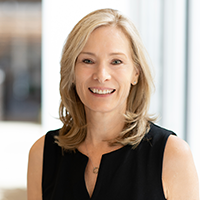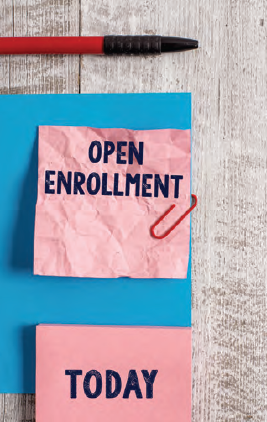Add online benefit fairs to your toolbox
BY LAURA KARES
It’s “go time” for many of your clients who are now in the thick of open enrollment — and the perennial benefit fairs that support it. What does your clients’ game plan look like this year for benefit communication — and does it have any new plays to meet the fluid dynamics of today’s workforce?
As a director of regional client management whose team focuses on West Coast clients at ARAG®, I’ve helped hundreds of California employers prepare for open enrollment (OE). I know they’ve relied heavily on the pivotal role — and impact — in-person benefit fairs have had on OE over the years. And yes, more in-person benefit fairs are popping back up in the post-pandemic workplace. But with the rapid transition to hybrid and remote work models, embracing technology is crucial to enabling a more virtual — and engaging — customer experience.
The pandemic prompts clients to shift gears
The pandemic served as the catalyst that drove transformative change in OE employee benefit communications in two significant ways.
First, prior to the pandemic, the majority of clients were used to doing benefit fairs in person; there was a comfort level there. With the disruption of the traditional workplace model, however, clients had to change — there was no going back. It forced them to rethink how they were going to conduct benefit fairs and communicate to employees during open enrollment. It was a brave new world as they were trying to determine what still worked, while exploring unfamiliar technological territory.
Second, with the explosion of remote work due to COVID-19 protocols, it prompted employees — including several of the high-tech clients our team manages in California — to not only work full-time from home, but to move altogether — because they could work from literally anywhere. This, in turn, caused a greater need to hold benefit fairs virtually to reach an increasingly mobile employee population that’s, frankly, just not coming back into the workplace.
It’s all part of the trend in accelerated digital transformation in HR turning into a necessity — and an opportunity for you to guide clients toward the finish line when it comes to retooling how benefit fairs, enrollment and education will look moving forward.
Offer creative, flexible solutions
My cohort Lindsay Deon, manager of Client Support Services, seconds that thought. “We’ve reinvented our approach many times to meet clients’ shifting needs and varying capabilities,” Deon said. She notes that during the pandemic, “Some employers were very adept at switching gears from in person to more virtual events, while others had to contend with outdated systems, processes, or infrastructure, which required providers like us to be more creative in finding solutions for them.”
Deon adds, “Technology has changed the way we look at open enrollment — and given us a much more robust package of options for how we present information to employees. We were compelled to become more agile and deliver a better experience for potential members due to their ability to connect in multiple ways. Having the access to information without having to physically show up to an event to learn about the benefits has increased awareness with our eligibles. And it’s also spurred us to craft our message in a way that really connects with people where they are in their lives post-pandemic.”
Deon explains, “Some of our largest clients have moved to a totally virtual model because it reaches so much further than a two to three hour in-person benefit fair could. We can record and save presentations so that individuals can learn on their own time and can reach out with specific questions that truly impact their lives — without having to disrupt their schedule to make it to an in-person benefit fair. Virtual options have given people the ability to schedule their work and lives in a way that makes most sense to them.”
In addition to being flexible with whatever technology they had to work with, the goal of Deon’s team was to offer clients clear, concise and continual communication about our legal insurance benefit through webinars, chat sessions, phone calls, Teams or Zoom meetings, banners, email communications, articles and white papers, just to name a few. We’ve also worked on:
- Creating “Benefit Fair in a Box”
– a toolkit that allows employers to provide employees with a fold-out table display and information for employees to view if ARAG can’t attend a benefit fair in person - Beefing up the capabilities of our online Client Service Center to make it easier for HR contacts to manage the enrollment information they transmit to us, and,
- Coordinating with clients to provide our benefit and contact information to employees through the virtual benefit platforms (e.g., vFairs) they were using.
Admittedly, a virtual option for benefit fairs is not a perfect model for all clients. You don’t get that emotional energy and enthusiasm that comes with face-to-face contact. But it is another tool in the arsenal to cater to what our clients’ specific needs are.
Since 2020, we’ve seen clients work to eliminate outdated processes and transition to a strong toolbox of virtual resources that provide greater flexibility and on-demand access to benefits information.
For employers or HR departments who are unsure of the advantages of embracing new technology to reach employees, encourage them to think outside the “benefits fair box.” Employees are accustomed to having on-demand access to the information they need, where they need it. Providing a more virtual option can make this possible.
Help your clients up their benefit enrollment game
So here we are — post-pandemic, great resignation, hybrid workforce — all forming a perfect storm of tech challenges and virtual opportunities on the horizon. Encourage your clients to focus not so much on whether to hold benefit fairs in person versus virtual, but rather creating a better enrollment experience for employees, whether they’re in an office or working from home. Try offering clients a variety of approaches that meet employees where they are (materials only, virtual and in-person — or a mix of all three).
The brokers I work with can play a wide range of roles in conducting benefit fairs, from simply serving as an intermediary between client and vendors to taking a more hands-on, planned approach. Consider how you might up your consulting game with the following strategies and tactics:
- Talk with clients about leveraging technology — or prioritize your investment in your firm’s tech capabilities — to reach their employees in the most efficient and convenient way possible.
- Speaking of technology, evaluate the “moment of truth” — when an employee actually logs in and selects their benefits. Ask clients, “Is it a self-guided enrollment experience that’s easy to access?”
- Record short, concise messaging such as videos or presentations that include a Q&A. Most benefit booklets that used to be printed are now
all electronic. Push the videos out periodically. Instead of one in-person benefit fair, your clients can leverage technology to get their messaging out over a week to potentially reach all employees. - Keep lines of communication open with clients to anticipate and plan your communication strategy so you can hit the ground running.
- Encourage clients to communicate in the “off-season,” not just during open enrollment, to discuss analytics and review what worked, what didn’t, and how you can evolve and improve for next year.
- Consider what additionalbenefits or tools might help your clients during these times of uncertainty. Consider voluntary benefits that address employees’ mental health or financial wellness — such as savings programs, student loan repayment and legal insurance.
While the OE game has changed significantly, it’s likely that benefit fairs — virtual, in-person or more likely hybrid — will continue to be valuable assets in OE. The good news is that we are seeing significant value in the virtual options as brokers and providers can tailor their messaging for specific clients’ needs — and give a more in-depth look as to how plan options can benefit their employees.
The key is to find a tech platform that supports virtual fairs, one that your clients are comfortable with and meets their needs from both a cost and features standpoint, and one that best mimics the characteristics of an in-person fair.

LAURA KARES serves as the director of Client Management, ARAG Western Region. A 13-year veteran at ARAG, Laura is passionate about providing members access to justice and is a strong advocate for easing the administration for her clients that include Microsoft, Oracle, and the State of California.
Contact: www.araglegal.com

